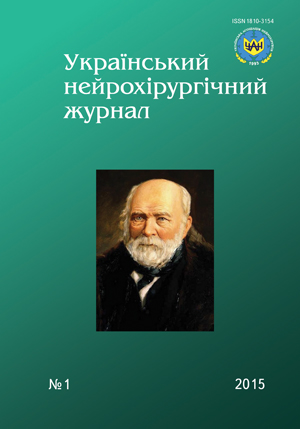The experience of stereotactic radiosurgery and radiotherapy use in combined treatment of pituitary adenomas
DOI:
https://doi.org/10.25305/unj.42393Keywords:
pituitary adenoma, stereotactic radiosurgery, neurosurgical operation, stereotactic radiotherapyAbstract
Introduction. Pituitary tumors take the third place in a structure of CNS neoplasms and ranged from 4 to 17% of all brain tumors.
The purpose. To study features of stereotactic ray methods in treatment of pituitary adenomas, to estimate efficacy of stereotactic radiosurgery and stereotactic radiotherapy in pituitary adenomas combined treatment.
Materials and methods. Stereotactic treatment was performed in 19 patients with pituitary macroadenomas (in 6 cases stereotactic radiosurgery was used, in 13 — stereotactic radiotherapy). Neurosurgical operations have been performed previously in 16 patients. In terms 3–6 and 9–12 month after stereotactic surgery MRI control with contrast was used.
Results. Tumor’s partial answer on MRI (regression at least 15% of primary focus volume) was noted in 54% cases, it’s stabilizing (±15% of tumor’s original volume) — in 46%. Over a period of 6 months after stereotactic treatment reduction of pituitary adenomas was in average 27%, over 12 months — 46%.
Conclusions. The experience of stereotactic radiosurgery and stereotactic radiotherapy use in patients with pituitary adenomas demonstrates the high efficacy of the methods, especially after partial removal of invasive and drug-resistant adenomas.
References
Galanov AV, Konovalov AN, Kornienko VN, Il'ialov SR, Kostiuchenko VV, Pronin IN, Mariashev SA, Iakovlev SB, Lubnin AIu, Serova NK, Nikonova NG. [First experience with a Gamma-knife unit used for radiosurgical treatment for intracranial space-occupying lesions]. Zh Vopr Neirokhir Im N N Burdenko. 2007 Jan-Mar;(1):3-10. Russian. PubMed
Sheehan JP, Niranjan A, Sheehan JM, Jane Jr JA, Laws ER, Kondziolka D, Flickinger J, Landolt AM, Loeffler JS, Lunsford LD. Stereotactic radiosurgery for pituitary adenomas: an intermediate review of its safety, efficacy, and role in the neurosurgical treatment armamentarium. Journal of Neurosurgery. 2005;102(4):678-691. CrossRef
Wan H, Chihiro O, Yuan S. MASEP gamma knife radiosurgery for secretory pituitary adenomas: experience in 347 consecutive cases. Journal of Experimental & Clinical Cancer Research. 2009;28(1):36. CrossRef
Stapleton C, Liu C, Weiss M. The role of stereotactic radiosurgery in the multimodal management of growth hormone–secreting pituitary adenomas. Neurosurgical FOCUS. 2010;29(4):E11. CrossRef
Akabane A, Yamada S, Jokura H. Gamma Knife Radiosurgery for Pituitary Adenomas. ENDO. 2005;28(1):087-092. CrossRef
Petrovich Z, Yu C, Giannotta S, Zee C, Apuzzo M. Gamma Knife Radiosurgery for Pituitary Adenoma: Early Results. Neurosurgery. 2003;53(1):51-61. CrossRef
Pamir MN, Kiliç T, Belirgen M, Abacioğlu U, Karabekiroğlu N. Pituitary adenomas treated with gamma knife radiosurgery. Neurosurgery. 2007;61(2):270-280. CrossRef
Lee CC, Kano H, Yang HC, Xu Z, Yen CP, Chung WY, Pan DH, Lunsford LD, Sheehan JP. Initial Gamma Knife radiosurgery for nonfunctioning pituitary adenomas. Journal of Neurosurgery. 2014;120(3):647-654. CrossRef
Paek SH, Downes MB, Bednarz G, Keane WM, Werner-Wasik M, Curran Jr WJ, Andrews DW. Integration of surgery with fractionated stereotactic radiotherapy for treatment of nonfunctioning pituitary macroadenomas. International Journal of Radiation Oncology*Biology*Physics. 2005;61(3):795-808. CrossRef
Becker G, Kocher M, Kortman RD, Paulsen F, Jeremic B, Müller RP, Bamberg M. Radiation therapy in the multimodal treatment approach of pituitary adenoma. J Strahlentherapie und Onkologie. 2002;178(4):173–186.
Radiosurgery Practice Guideline Initiative: Stereotactic Radiosurgery For Patients With Pituitary Adenomas. The IRSA (International RadioSurgery Association); 2004. Available at: http://www.irsa.org/Pituitary%20Guideline.pdf. Accessed April 17, 2014.
Greenberg MS. Handbook of neurosurgery. 5th ed. New York: Thieme, 2001. 1331 p.
Kondziolka D. Radiosurgery. Basel: Karger; 2006. CrossRef
Prasad D. Gamma Knife Surgery And Microsurgery: A Comparison Of Published Results. San Diego Gamma Knife Center; 2010. Available at: http://www.sdgkc.com/wp-content/uploads/2010/09/LGK-Microsurgery-Published-Results.pdf. Accessed April 17, 2014.
Park KJ, Kano H, Parry PV, Niranjan A, Flickinger JC, Lunsford LD, Kondziolka D. Long-term outcomes after gamma knife stereotactic radiosurgery for nonfunctioning pituitary adenomas. Neurosurgery. 2011;69(6):1188-1199. CrossRef
Liu X, Kano H, Kondziolka D, Park KJ, Iyer A, Shin S, Niranjan A, Flickinger JC, Lunsford LD. Gamma knife stereotactic radiosurgery for drug resistant or intolerant invasive prolactinomas. Pituitary. 2012;16(1):68-75. CrossRef
Downloads
Published
How to Cite
Issue
Section
License
Copyright (c) 2015 Andrey Gryazov, Olga Chuvashova, Nikolay Guk, Aleksandr Guk, Yuliya Medvedovskaya, Elena Andriychenko, Vitaliy Zakordonets

This work is licensed under a Creative Commons Attribution 4.0 International License.
Ukrainian Neurosurgical Journal abides by the CREATIVE COMMONS copyright rights and permissions for open access journals.
Authors, who are published in this Journal, agree to the following conditions:
1. The authors reserve the right to authorship of the work and pass the first publication right of this work to the Journal under the terms of Creative Commons Attribution License, which allows others to freely distribute the published research with the obligatory reference to the authors of the original work and the first publication of the work in this Journal.
2. The authors have the right to conclude separate supplement agreements that relate to non-exclusive work distribution in the form of which it has been published by the Journal (for example, to upload the work to the online storage of the Journal or publish it as part of a monograph), provided that the reference to the first publication of the work in this Journal is included.









